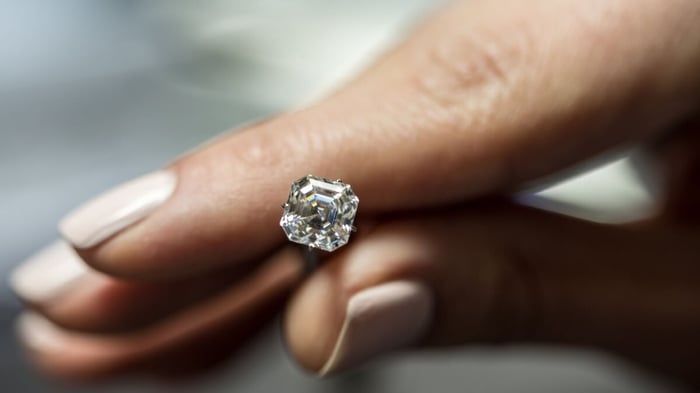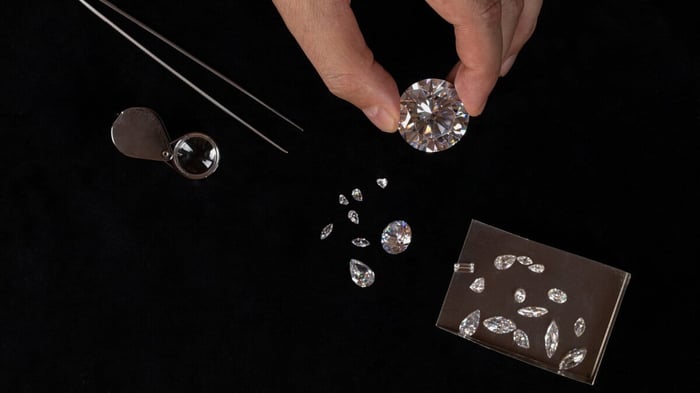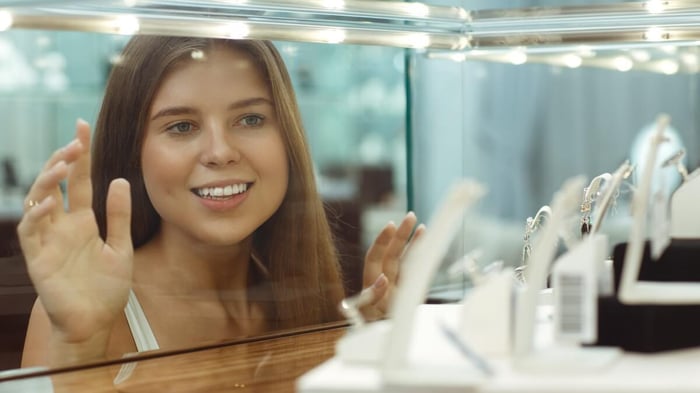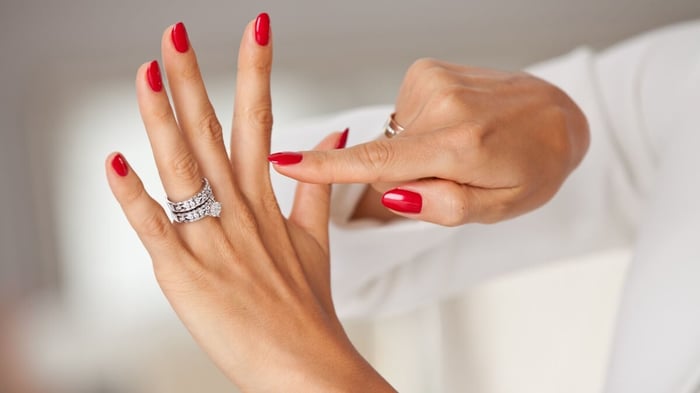Should You Choose Asscher Cut Diamonds For Your Jewellery?
Today we're going to talk about Asscher Cut diamonds. This diamond shape is very underrated but offers a great alternative to the classic round-cut diamond in engagement rings and other types of diamond jewellery.
Jewellery designers don't get to work with the Asscher cut as much as some other shapes, which is unfortunate because it's such a beautiful stone.
The Origin Of The Asscher Cut Shape
The Asscher cut dates back to 1902; it was designed by Joseph Asscher, hence the name. Although we think of it as being a square shape diamond, it is actually an octagon with eight sides. In most cases, the corners are concealed by the prongs or claws holding the diamond in its setting, which gives the visual effect of a square. A bezel or rub-over setting can show off the shape of the diamond to great effect. Because of its age, the shape is often associated with vintage style and elegance.

The Look Of An Asscher Cut Diamond
The Asscher cut is very similar to the emerald, except that it is square in shape as opposed to the Emerald Cut, which is rectangular. The Asscher cut is another step-cut diamond. With this shape, you get beautiful steps into the centre. When the stone is cut correctly, you should see a series of squares within each other.
When viewed from above, an Asscher cut diamond appears to have the appearance of an X. This design is created by converging equidistant facets that centralise toward the culet on the pavilion side of the bottom centre of the stone. When viewed from the stone's side profile, it is possible to see that the crown is higher than the crowns of other diamond cuts.
The step-cut design lends itself to many different types of ring styles. My favourite style is to keep the design very clean with a solitaire or even a delicate bezel (rub over) setting, both of which look very beautiful.
Often you'll find Asscher Cut diamonds in three-stone rings. You can also find a lot of beautiful art deco designs that feature halos or pave accent diamonds, allowing the Asscher to become part of a more significant design concept.

Asscher Cut Diamond Quality Goals
When thinking about the four Cs of diamond quality, one of the most important things to focus on is the cut grade. Seeing those steps into the centre and the concentric square pattern is what is so beautiful about the Asscher. If the symmetry and proportions of the cut diamond are not very good, the steps will become uneven, and the square becomes more of a rectangle. That means the cutting of the diamond must be very well executed.
When you buy a piece of diamond jewellery with an Asscher cut, look out for diamonds with an excellent cut grade.
The Asscher shows colour quite nicely; this can be a disadvantage in the lower colour grades. At All Diamond, we tend to stick with the G (near colourless) colour grade as this is a sweet spot for colour quality and price. Some of our jewellery features the next higher grade, F, which is classified as colourless but comes at a significantly higher price.
When it comes to clarity, the Asscher is not very good at hiding imperfections, as you can imagine, because of the open facets. You can see almost anything that's going on inside the stone. SI (slightly included) and above is the safety zone, with VS1 being better if your budget will stretch that far. In smaller diamonds, the clarity grade is less important as the facets become much smaller. In normal situations, internal flaws and inclusions in a smaller stone are much harder to spot. Most of our Asscher diamonds are of SI or better quality.
Certified Diamond Solitaire Engagement Ring 0.33ct E/VS Quality in Platinum
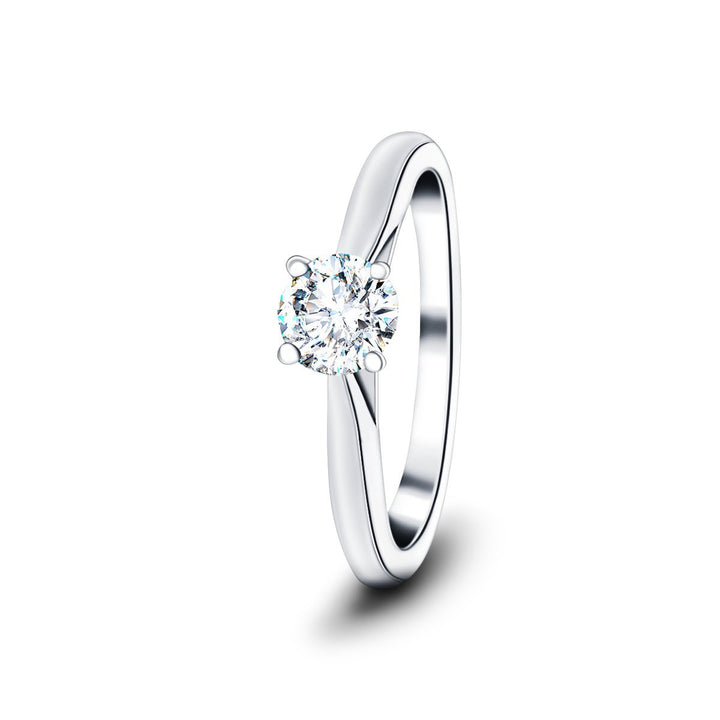
£918.00
£1,507.00
Add a modern finishing touch to any outfit with this elegant diamond engagement ring. Designed with elegant white diamonds, this special piece is sure to be admired. The 0.33 carat diamond provides the brilliant sparkle for which diamonds are known.… read more
Asscher Cut Diamond Shape
The shape of the Asscher is generally a perfect square with a one-to-one ratio meaning that all the long and corner sides match each other. Sometimes you will see slightly off-square, slightly rectangular versions as well. As you get more rectangular, it will start to look more like a square emerald cut. Many people ask what the difference between an Asscher and an Emerald cut is. There really isn't a difference except that a square emerald is not very often cut. If you're looking for a square, step-faceted diamond, then Asscher will be the way to go.
Asscher And Other Shapes Compared
If you're looking for diamonds similar to the Asscher but prefer to have more sparkle rather than the glow of the Asscher, the radiant cut is a good way to go. Both these shapes have clipped corners.
The real difference between the Asscher and Radiant cuts is how they're faceted. The Asscher cut has stepped facets, whereas the Radiant is cut with brilliant facets. The latter sparkles similarly to a round diamond, whereas the step cut has more of a flash to the sparkle. The Asscher is about subtle flashes of light versus the Radiant with that sparkle factor.
Another popular squarish shape is the cushion cut. This shape is somewhat square, but as the name suggests, the edges of the diamond will be somewhat curved. Cushion-cut diamonds are faceted to give more sparkle. A cushion cut often looks like a squarish round diamond rather than a square diamond. Most of our clients prefer the sparkle of cushion, princess and radiant cut diamonds over the Asscher.
Certified Diamond Halo Cushion Engagement Ring 1.15ct Platinum
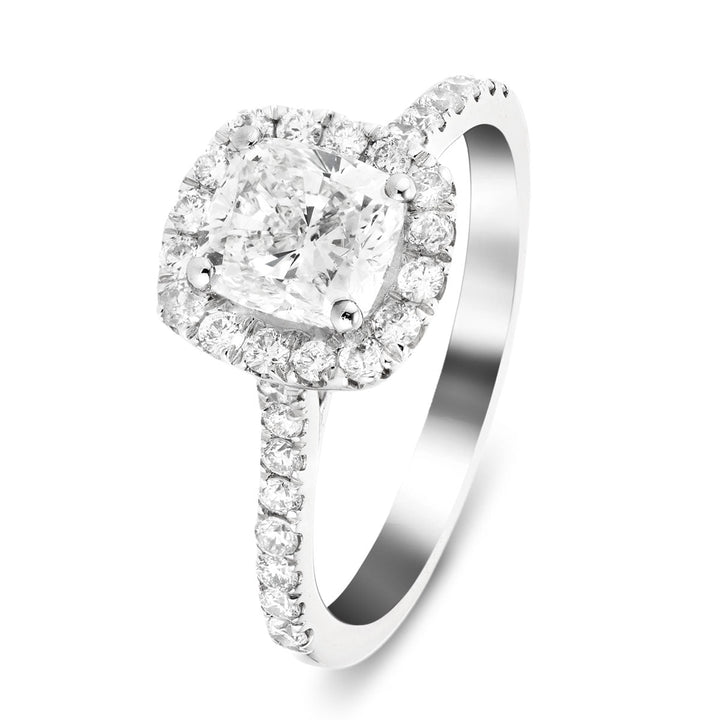
£2,809.00
£5,017.00
This classic diamond engagement ring has sparkling hand-cut and set diamonds is a piece to pair with the most sophisticated ensembles. The centre cushion cut diamond is surrounded by a sparkling halo of melee diamonds and the pure white platinum… read more
Asscher Cut Diamonds Apparent Size
When considering an Asscher cut diamond, an important point to remember is that an Asscher will tend to look slightly smaller than a round diamond for the same carat weight. That is because more of the weight of the Asscher is concentrated in the stone’s centre, the belly, than in a round diamond. On the other hand, because of the square shape, an Asscher can look more visually imposing than a round diamond because the square shape gives a larger diagonal than a round diamond.
The Asscher cut is growing in popularity now because of its elegant and subtle visual effect compared to the bling of round and radiant diamonds.
The Asscher cut gives designers a way to create something that looks a little different and stands out from other diamond jewellery. If you want something that’s a little bit different, then an engagement ring or other diamond jewellery with an Asscher cut diamond is a great option.
Although the Asscher cut is a lovely type of diamond, most buyers prefer to have the extra sparkle and brilliance of a faceted diamond, exemplified by the cushion and princess cuts.
If you would like to have our designers create a wonderful, unique piece using Asscher cut diamonds, please contact us, and we can work with you to create a piece that you can be sure will be absolutely one-of-a-kind!
